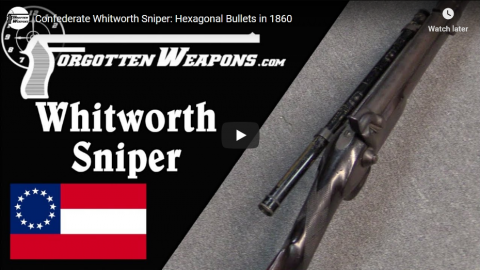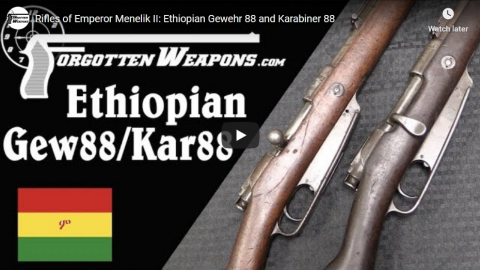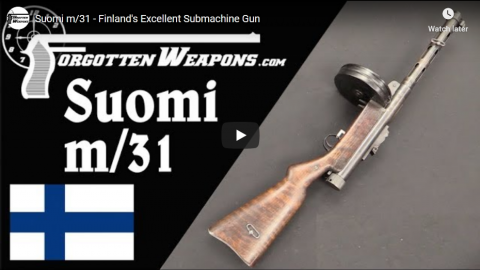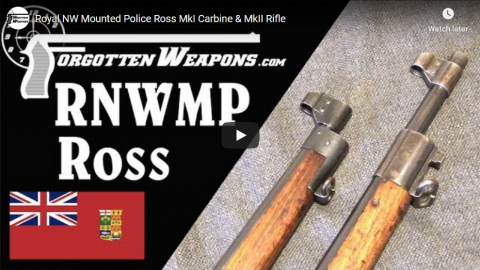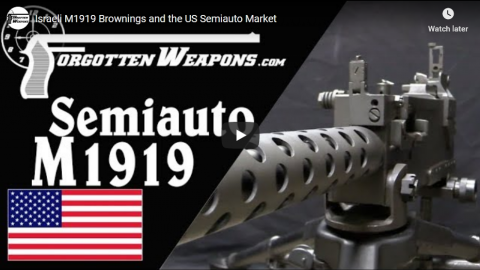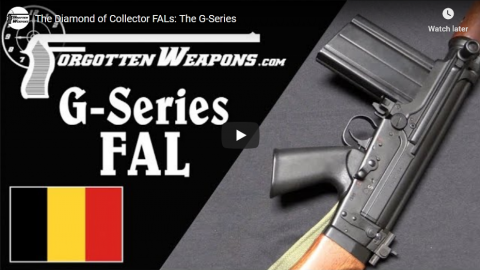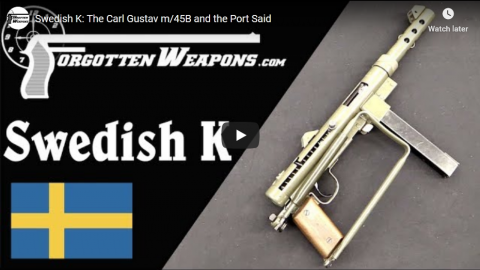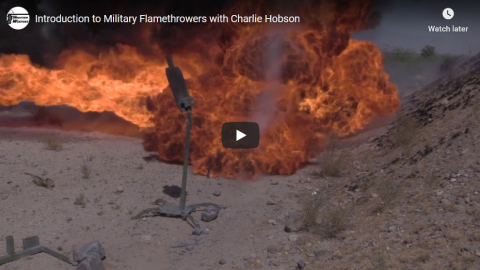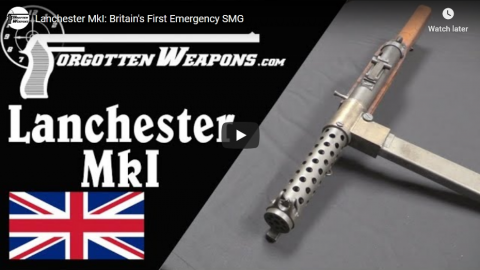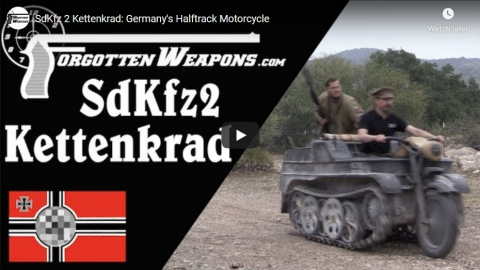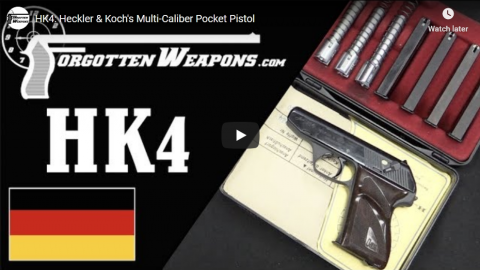Forgotten Weapons
Published 12 Oct 2017NOTE: Please see this video for a correction regarding Whitworth accuracy: https://youtu.be/cUd2RQGfL7E
Sold for $161,000.
Sir Joseph Whitworth is quite the famous name in engineering circles, credited with the development of such things as Whitworth threading (the first standardized thread pattern) and engineer’s blue. When he decided to make a rifle, he decided that he could make flat surfaces more precisely than round ones, and chose to design a rifle with a hexagonal bore and mechanically fitted bullets.
The Whitworth rifles proved to be magnificently accurate, with a British military test showing a group of 0.85 MOA at 500 yards, and under 8MOA even at 1800 yards. However, the rifles were equally expensive, and were not given further consideration for military use. Whitworth made a total of about 13,700, selling them to high level competitive marksmen and wealthy shooting enthusiasts. A small number were purchased by Confederate agents during the Civil War, and between 50 and 125 were able to evade the Union blockades to be delivered into Confederate hands. These rifles were equipped with Davidson 4-power telescopic sights, and they were put to extremely good effect by Confederate sharpshooting units. In particular, they were used to shoot at Union artillery crews, and Whitworth bullets have been found on a great many Civil War battlefields. They were not available in large numbers, but they were excellent rifles and put to use as much as possible.
Given the small number originally brought into the CSA, the number of known surviving examples is extremely low. This one, like many, was found without its scope and mount, and those parts have been replaced with period examples. As a true Confederate Whitworth, however, this is an extremely rare and historically relevant rifle!
http://www.patreon.com/ForgottenWeapons
Cool Forgotten Weapons merch! http://shop.bbtv.com/collections/forg…
If you enjoy Forgotten Weapons, check out its sister channel, InRangeTV! http://www.youtube.com/InRangeTVShow
February 8, 2020
Confederate Whitworth Sniper: Hexagonal Bullets in 1860
February 6, 2020
Rifles of Emperor Menelik II: Ethiopian Gewehr 88 and Karabiner 88
Forgotten Weapons
Published 5 Feb 2020http://www.patreon.com/ForgottenWeapons
https://www.floatplane.com/channel/Fo…
Cool Forgotten Weapons merch! http://shop.bbtv.com/collections/forg…
In 1889, Emperor Menelik II ascended to power in Ethiopia, and would rule for 20 years, moving Ethiopia (aka Abyssinia) forward into the modern age. He brought railways, sewer systems, telegraph lines, and other modern amenities to the country, particularly the capital of Addis Ababa. In addition, Menelik II was a very capable logistician and military strategist, and decisively defeated an Italian colonial invasion at the Battle of Adwa in 1896. This victory was made possible by Ethiopian acquisition of modern arms of many types. Early support came from Orthodox Russia in the form of Berdan rifles, but other arms would flow into the country as well, including Gewehr 88 and Karabiner 88 rifles and carbines. These two are marked in Amharic as Menelik’s property, and are a part of what allowed Ethiopia to be the only major African nation not colonized by Europe.
Thanks to InterOrdnance for giving me access to these rifles to bring to you!
Contact:
Forgotten Weapons
6281 N. Oracle #36270
Tucson, AZ 85740
February 5, 2020
Suomi m/31: Finland’s Famous Submachine Gun
Forgotten Weapons
Published 12 Sep 2017For some great firing footage and an assessment of the m/31 in practical terms, check out today’s video on InRangeTV: https://www.youtube.com/watch?v=6HJMv…
http://www.patreon.com/ForgottenWeapons
Cool Forgotten Weapons merch! http://shop.bbtv.com/collections/forg…
Designed by Finland’s most notable arms inventor, Aimo Lahti, the m/31 Suomi submachine gun is an iconic weapon of the Winter War and the Continuation War. It is a first-generation submachine gun with a heavy milled receiver and very well-fitted parts — enough so that a series of vent holes were put in the end of the receiver tube to prevent air compression during the firing cycle. The gun is overall quite heavy (4.7kg / 10.4lb) and has a high rate of fire (~900 rounds/minute). It originally used 50-round quad-stack magazines and 71-round drum magazines, which allowed a shooter to exploit the high rate of fire without constantly having to change magazines.
The quad-stack magazines were eventually found to be insufficiently reliable, and were retired. The drum proved to be quite good in use, although quite awkward and bulky to carry (note that Finnish troops had no specialized pouches for these drums). The drum design would be taken by the Russians (handed over by a defecting Finnish officer, apparently) and copied for use in the Soviet PPD and PPSh submachine guns. In the 1950s, a simple double-stack 36 round magazine was developed and became most popular.
If you enjoy Forgotten Weapons, check out its sister channel, InRangeTV! http://www.youtube.com/InRangeTVShow
February 3, 2020
Royal NW Mounted Police Ross MkI Carbine & MkII Rifle
Forgotten Weapons
Published 31 Jan 2020http://www.patreon.com/ForgottenWeapons
https://www.floatplane.com/channel/Fo…
Cool Forgotten Weapons merch! http://shop.bbtv.com/collections/forg…
One of the very early clients of the Ross Rifle Company was the Royal North West Mounted Police (later merged with the Dominion Police to form the RCMP). The Mounties purchased 500 Ross MkI carbines, which were actually the only factory-made Ross carbines ever produced. The guns were made in 1904 and delivered in 1905 — and quickly began to show problems. In particular, the bolt stops were unreliable and many springs had poor temper and lost strength. The RNWMP complained to Ross, who agreed to replace the carbines with new MkII Ross rifles.
Those new rifles did not arrive until 1909, and in the intervening years the police went back to issuing their old Lee Metford carbines. When they did finally get new rifles, the police commissioner was leery of their quality, and chose to hold them in storage at Regina headquarters and used for training and marksmanship competition only until he was confident that they were suitable for issue to his troopers. Before that confidence could be gained, however, a fire in the Regina warehouse destroyed all but 34 of them. Ultimately, the force was able to purchase Lee Enfield carbines from the British government in 1914, and never did successfully issue a Ross.
Many thanks to the collector who provided these original RNWMP guns for me to show you!
Contact:
Forgotten Weapons
6281 N. Oracle #36270
Tucson, AZ 85740
February 2, 2020
Israeli M1919 Brownings and the US Semiauto Market
Forgotten Weapons
Published 28 Mar 2018Sold for $4,888.
In the world of converted semiautomatic “machine guns,” the Browning 1919 is a happy example of one of the most iconic and historically important US machine guns and also one of the cheapest semiautomatic belt fed guns available. This stems from two factors, primarily. One is that the Browning 1919, being developed from the water-cooled M1917 Browning, is a closed bolt system. Open bolt semiautomatic designs are not allowed by ATF, and so most semiauto machine gun conversions require substantial alteration to convert from open bolt to closed bolt — which the M1919 does not need. Second, the IDF used the Browning M1919 for many years and in large numbers, and surplussed many of them in the late 1990s. These guns came into the United States as parts kits in large numbers. This meant a glut of cheap guns, easily built as semi autos, and in an easily shootable caliber — 7.62mm NATO (as converted by Israel from their original .30-06 chambering).
Today, we are looking at an example of a semiautomatic converted M1919, and specifically at the various changes made by Israel to both improve the design and convert it successfully to the NATO cartridge.
http://www.patreon.com/ForgottenWeapons
Cool Forgotten Weapons merch! http://shop.bbtv.com/collections/forg…
If you enjoy Forgotten Weapons, check out its sister channel, InRangeTV! http://www.youtube.com/InRangeTVShow
January 29, 2020
M20A1B1 Super Bazooka – It’s a Super Bazooka. Need I Say More?
Forgotten Weapons
Published 28 Oct 2017Sold for $1,380 (deactivated).
The US was one of the few major military powers that went into World War II without a substantial infantry antitank weapon. Most countries had an antitank rifle of some sort, but the US just had some marginal antitank rifle grenades. That was rectified in late 1942 when the M1 Rocket Launcher — aka the Bazooka — was introduced. Using a 2.36″ shaped charge warhead, it was able to penetrate about 4.7 inches of armor, which was effective through most of the war. A larger version went into development in 1943 though, because it was clear that the M1 would soon become obsolete.
The 3.5″ M20 Super Bazooka was adopted in late 1945 and put into production in 1948, with its first combat use coming in the Korean War. It was much more powerful, capable of penetrating 11 inches of armor plate. The launcher itself weighed just 13 pounds, with each rocket adding another 8.9 pounds. This, and the updated M20A1, would serve as the main US infantry antitank weapon until replaced by the 90mm recoilless rifle in the 1960s.
http://www.patreon.com/ForgottenWeapons
Cool Forgotten Weapons merch! http://shop.bbtv.com/collections/forg…
If you enjoy Forgotten Weapons, check out its sister channel, InRangeTV! http://www.youtube.com/InRangeTVShow
From the comments:
WeirdHarold49
2 years agoSince Ian forgot and Wikipedia knows:
Origin of the “bazooka” name
Shortly after the first prototype launcher and rockets had been tested by firing into the Potomac River, Skinner and Uhl took the new system to a competitive trial of various types of spigot mortar (at that time seen as the most promising way to deliver a shaped charge), which was held at the Aberdeen Proving Ground in May 1942. The new rocket launcher scored several hits on a moving tank while the five different mortars achieved none; this was a considerable achievement since the launcher’s sights had been fabricated that morning from a wire coat hanger. The trial was being watched by various senior officers, among them the Chief of Research and Engineering in the Ordnance Department, Major General Gladeon M. Barnes. Barnes was delighted by the performance of the system and fired it himself, but commented: “It sure looks like Bob Burns’ bazooka”. Bob Burns was a popular radio comedian, who used a novelty musical instrument which he had devised himself and called a “bazooka”.
January 26, 2020
The Diamond of Collector FALs: The G-Series
Forgotten Weapons
Published 2 Apr 2018Sold for $17,250.
When the Browning Arms Company first began importing semiautomatic FAL rifles from FN in 1959, the submitted an example for evaluation, and ATF determined that it was not a machine gun. The rifle was made with a selector that could not be moved to the fully automatic position, and did not have the automatic sear required for full auto firing. This was acceptable at the time, and Browning would import 1,836 of these rifles (mostly standard configuration, but some heavy barrel and paratrooper patterns) by January 10, 1963. On that date, ATF changed its standard, and ruled the FAL as currently being imported now would be considered a machine gun subject to the NFA. In order to be acceptable now, the rifle must not be able to accept an automatic sear at all, not merely be made without one. However, ATF ruled that the previously imported guns would be grandfathered in, and remain legally owned as semiautomatic rifles. They were listed by serial number (an additional 12 guns were added in 1974 which were imported by “administrative error”), and remain exempted from the NFA to this day. For the FAL collector, these G-series rifles are desirable because they are completely authentic and original early FN production guns, without any of the design changes that would be required later for importation.
Exempt serial number list: http://www.gseriesfal.com/docpages/91…
http://www.patreon.com/ForgottenWeapons
Cool Forgotten Weapons merch! http://shop.bbtv.com/collections/forg…
If you enjoy Forgotten Weapons, check out its sister channel, InRangeTV! http://www.youtube.com/InRangeTVShow
January 25, 2020
Swedish K: The Carl Gustav m/45B and the Port Said
Forgotten Weapons
Published 24 Jan 2020http://www.patreon.com/ForgottenWeapons
https://www.floatplane.com/channel/Fo…
Cool Forgotten Weapons merch! http://shop.bbtv.com/collections/forg…
During the 1930s, Sweden acquired an assortment of different submachine guns, including Bergmanns, Thompsons, and Suomis. As World War Two progressed, they decided that they really needed to standardize on a single caliber and model of gun, and requested designs from both the Carl Gustav factory and Husqvarna. The Carl Gustav design won out, and was adopted as the m/45.
It was a very simple open-bolt, tube-receiver, fixed-firing-pin design chambered for 9x19mm Parabellum ammunition. The original guns were built around Finnish Suomi magazines, both 71-round drums and 50-round “coffin” mags. After the war these were replace by a new 36-round traditional box magazine, and magazine well adapters were fitted to the guns which precluded the use of the larger mags. The new magazines were much more convenient to carry, less expensive, and more reliable.
The name “Swedish K” comes form the full designation: Kulsprutepistol m/45. The guns were used by American special operations forces in Vietnam until the Swedish government stopped export sales to the US, at which point the Navy commissioned Smith & Wesson to produce the Model 76 submachine gun (essentially a copy of the m/45). The design was also licensed by Egypt, which also licensed the AG-42 Ljungman rifle at the same time. The Egyptian copy was called the Port Said, and shows the features fo the original Swedish m/45 pattern, where the guns in Swedish service were mostly updated to the m/45B pattern.
Photo of m/45C with bayonet from: http://www.gotavapen.se/index_eng2g.htm
Check them out for a ton of information on Swedish small arms!
Contact:
Forgotten Weapons
6281 N. Oracle #36270
Tucson, AZ 85740
January 23, 2020
Book Review – The Lee Enfield, by Ian Skennerton
Forgotten Weapons
Published 21 May 2017Available from Amazon: http://amzn.to/2qBntgB
Ian Skennerton is a leading authority on British rifles, having written extensively on Sniders, Martinis, Enfields, and more. This specific book, The Lee Enfield is the most recent iteration of his compendium of Lee-Enfield information, printed in 2007 (previous versions were The Lee Enfield Story of the 1980s and The British Service Lee of the 90s). It is an absolute wealth of information, including a large amount of original British military documents. Skennerton covers a huge array of developmental and experimental versions of the Enfield as well as the standard production models (including American, Canadian, Australian, and Indian production).
Strange WW1 modifications and accessories, grenade launchers, snipers, lightweight guns, carbines, long rifles, semiautomatic conversions, you name it — it’s all here. Unfortunately, the organization and editing leaves a lot to be desired, in my opinion. It is a book that looks magnificent when idly flipped through, but can be frustrating to use to understand the history of a gun or guns. The text often jumps from one subject to another, forcing the reader to piece together elements from different sections to figure out a coherent story.
That said, it remains an indispensable book for the Enfield enthusiast, as it has a ton of information not found elsewhere. I hope that if a new revision or edition is ever produced, Mr. Skennerton will employ the services of a ruthless editor to help him form the raw information into a more navigable history.
Cool Forgotten Weapons merchandise! http://shop.bbtv.com/collections/forg…
http://www.patreon.com/ForgottenWeapons
If you enjoy Forgotten Weapons, check out its sister channel, InRangeTV! http://www.youtube.com/InRangeTVShow
January 22, 2020
Introduction to Military Flamethrowers with Charlie Hobson
Forgotten Weapons
Published 5 May 2016http://www.flamethrowerexpert.com
You can find Charlie Hobson’s book, US Portable Flamethrowers here:
http://amzn.to/1SP9yc5Flamethrowers are a significant piece of military weapons history which are very widely misunderstood, as flamethrowers have never been the subject of nearly as much collector interest as other types of small arms. The US military removed its flamethrowers from inventory in 1985, and all other major national militaries have done the same. In the US, the lack of general interest led to most of the surplussed weapons being destroyed as scrap, and few survive in private collections. At the same time (and for the same reason) a great deal of the information on these weapons was also discarded and lost.
One of the people who has done a tremendous amount of work to recover practical information on historical military flamethrowers as well as restore, service, and operate them is Charlie Hobson. He has worked extensively with the US military museum system as well as the entertainment industry (if you have seen a movie of TV show using a real flamethrower, it was almost certainly done under his supervision).
Today I am discussing the basic of flamethrowers with Charlie. The goal is to provide a good baseline foundation so we can go on to look at a couple specific historical flamethrowers and understand them in context. So sit back, relax, and enjoy a chat with a man who is truly passionate about this underappreciated aspect of military history!
January 20, 2020
Lanchester MkI: Britain’s First Emergency SMG
Forgotten Weapons
Published 5 Sep 2017Sold for $16,100 (transferrable).
The Lanchester MkI was the first British effort to produce a domestic submachine gun during World War II. The British military had rejected these types of arms as “gangster guns” prior to the war, and did not see them as useful in a military context. Well, that opinion changed rather quickly as they watched the German blitzkrieg sail through continental Europe.
The very first solution was to purchase Thompson SMGs from the United States, but these were extremely expensive weapons, and not a suitable long term plan. The next solution was to reverse engineer a pair of German MP28 SMGs captured in Ethiopia. This was done by a Sterling company engineer named George Lanchester, and it was a successful project. Both the Royal Navy and Royal Air Force purchased the guns (although the RAF would cancel its order later, and the guns would pretty much all go to the Royal Navy).
Mechanically, the Lanchester is a very close copy of the MP28, with a few stylistic changes. These include the use of an SMLE pattern stock, the addition of a bayonet lug for a 1907 pattern bayonet, and the use of brass or bronze for the magazine housing instead of steel. The original MkI Lanchesters were select-fire, with a lever to allow semi or full-auto fire. This was removed with the simplified MkI* pattern, however.
The Lanchester would be quickly followed by the Sten gun, which offered much cheaper and faster manufacture, and the British Army would use huge numbers of Stens. The Lanchester would stay in service for decades after the war, though, serving on many naval vessels in British service and with other nations when British ships were sold as surplus.
http://www.patreon.com/ForgottenWeapons
Cool Forgotten Weapons merch! http://shop.bbtv.com/collections/forg…
If you enjoy Forgotten Weapons, check out its sister channel, InRangeTV! http://www.youtube.com/InRangeTVShow
January 17, 2020
HK4: Heckler & Koch’s Multi-Caliber Pocket Pistol
Forgotten Weapons
Published on 28 Aug 2019RIA on YouTube: https://www.youtube.com/user/RockIsla…
RIA on Instagram: https://www.instagram.com/rockislanda…The H&K Model 4 was named for the fact that it was offered in four different calibers – .22LR, .25 ACP, .32 ACP, and .380 ACP. The gun came with a complete set of spare barrels and magazines to allow conversion between all of them, and interesting feature not offered by any other pistols like it at the time. The design was by Alex Seidel, one of the founding engineers of H&K. He had familiarity with the Mauser HSc from his time working at Mauser, and it was the rough basis fo the HK4.
The changes between centerfire calibers required nothing more than swapping barrels (and recoil springs, which were pinned to the barrels) and magazines. Differing spring strength for each caliber were enough to make the gun both safe and reliable in the different chamberings. To convert to .22LR rimfire, it was also necessary to unscrew the removable breech face and flip it around. The breech face had two firing pin holes (one centerfire and one rimfire), and the firing pin could pivot enough to use either one. When the breech face was removed, the firing pin could be positioned for whichever setting was desired.
The HK4 was interesting and reasonably successful, but never able to really compete with guns like the Walther PP and PPK. During a 16-year production run from 1968 until 1984 a total of 38,200 were made, including 12,400 for the German customs police.
http://www.patreon.com/ForgottenWeapons
Cool Forgotten Weapons merch! http://shop.bbtv.com/collections/forg…
Contact:
Forgotten Weapons
PO Box 87647
Tucson, AZ 85754
January 16, 2020
Book Review: The Ministry of Ungentlemanly Warfare by Damien Lewis
Forgotten Weapons
Published 24 Sep 2017Get your copy on Amazon: http://amzn.to/2xwfDZ8
I ordered a copy of Damien Lewis’ book on the exploits of British SOE in WWII expecting to find an overview of, well, what SOE had done during the war. That’s not quite what this book is. Instead, Lewis has given us essentially a first-person view of SOE’s work through the eyes of Danish commando Anders Lassen (VC, MC with two bars). Don’t be fooled by the cover image; the North African LRDG is never mentioned. However, what Lassen was involved in was equally impressive and probably less well known.
Lassen was part of the crew for the first real SOE operation, the theft of a pair of German and Italian supply ships from the neutral Spanish port at Fernando Po. In an exploit that could be straight out of Hollywood, a band of commandoes sailed a pair of tugboats into the harbor at night while the ships’ officers were ashore at a raucous party. They blew the anchor chains with explosive charges, locked the crews below deck, and sailed the ships out to sea where they could be legally captured by a British destroyer. And they did it without a single death on either side.
The exploits only became bigger and bolder after that, with Lassen and his comrades making regular raids across the English Channel and running a freewheeling campaign of both hit-and-run raids and occupation of Greek islands in the Aegean. These were the quintessential independent Special Forces fighters, operating outside regular military command structures and supply chains, fighting as they saw fit. Lassen eventually became the commanding officer of a large group, and by the end of the war had been awarded the Military Cross three times. His last operation in Italy — where his men were hit with a shattering defeat when pushed into the role of spearheading a conventional offensive — would result in him posthumously receiving the Victoria Cross for his heroism.
I ended up reading the book almost entirely in a single sitting, and found it riveting and fascinating — far more so than the typical academic history. It offers a humbling and motivating example of what men can do when they are skilled and motivated. At the same time, it also left me a bit melancholy, as by the end we can see Lassen consumed by his combat experiences and slowly becoming removed from society. Nobody can say how Lassen would have coped had he survived the war, but one suspects he would have led a troubled life. Perhaps that is the price one must pay to become, as Churchill described, “a hand of steel which plucks the German sentries from their posts with growing efficiency.”
http://www.patreon.com/ForgottenWeapons
Cool Forgotten Weapons merchandise! http://shop.bbtv.com/collections/forg…
If you enjoy Forgotten Weapons, check out its sister channel, InRangeTV! http://www.youtube.com/InRangeTVShow
January 12, 2020
Three Variations of Party Leader PPK Pistols
Forgotten Weapons
Published 25 Oct 2019Note: I goofed on a detail here; “DRGM” is a trademark designation, not something related to the party. Sorry!
http://www.patreon.com/ForgottenWeapons
Cool Forgotten Weapons merch! http://shop.bbtv.com/collections/forg…
Today, courtesy of Tom from Legacy Collectibles, we are taking a look at “party leader” PPK pistols. There are three different versions of these, and we will look at all of them in sequence. They are highly valued in the collecting community, and also extremely easy to fake, making authentication quite difficult. I will give you as much information as I can to assist in this, and Tom is happy to help (free of charge) as well.
To see more about Legacy, check out their YouTube channel:
https://www.youtube.com/channel/UCesj…
Contact:
Forgotten Weapons
6281 N. Oracle #36270
Tucson, AZ 85704

